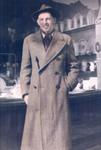Born 1761, Died 1842
Married: Henrietta Springer
Richard Beasley was born on July 21, 1761 in Albany, New York. The Beasley family were supportive of the British in the troubles of the American Revolution, and so in 1776 most of the family moved to Kingston. Richard, however, now 16 years old and a member of Rogers’ Rangers, fled to the Niagara Region. Upon his arrival in Upper Canada, Richard Beasley acted as Assistant Commissioner at Ft. Niagara. In 1795 he was granted by the government a tract of 12,000 acres at the western end of Lake Ontario, commonly called the Head of the Lakes in those days. Here he built a residence and a store which was part Indian trading post. He also was part owner of a flour mill at Ancaster with Jean Baptiste Rousseau and James Wilson. Beasley married Henrietta Springer whose family were also “Loyalists” to the British Crown. Richard became a member of the Legislative Assembly and was well-connected with the chief political figures of the day. He was named Speaker of the House in 1803. Around this time Chief Joseph Brant, representing the Six Nations Indians, decided to sell portions of their grant from the British Crown situated along the Grand River. Along with partners Jean Baptiste Rousseau and James Wilson, he purchased Block #2 of these lands in 1798. Soon after, he sold these lands to certain Mennonites from Pennsylvania. But these prospective settlers soon found that they could not get clear title to the land because Beasley had an outstanding mortgage in favour of the Six Nations Indians. This problem was solved when the German Company was formed in Pennsylvania to buy 60,000 acres in Block #2 from Beasley who then was able to discharge his debt and give full title to the Mennonites. He continued as a person of high repute in Upper Canada, rubbing shoulders with influential personages including Lieutenant-Governor John Graves Simcoe. He became a Colonel in the York Militia and served in the War of 1812-14. Colonel Beasley died on Feb 16, 1842 and was buried in the churchyard of Christ Church Cathedral (Anglican) in Hamilton.
Sources:
1. Cambridge Mosaic
2. Marg Howell, Ed Devitt and Pat McKegney, Welcome to Waterloo.
3. Robert L. Fraser, Richard Beasley. Dictionary of Canadian Biography, Vol 7. 1836- 1850 Frances G Halpenny, Ed University of Toronto Press, Toronto, 1988
4. Letter from David Beasley who is a descendant of Richard Beasley.
5. James O'Meara, Biographical Sketches of Legislative Assembly Members 1792-1867, Waterloo Historical Society, Volume 69, 1981.
Richard Beasley Biography
Description
- Creator
- Little, Ellis, Author
- Media Type
- Text
- Item Type
- Articles
- Description
- This is a handwritten biography of Richard Beasley from the Ellis Little Papers. This biography has been transcribed exactly as written. Ellis Little was a local historian, who was the principal of Elizabeth Ziegler Public School. On his retirement, he invested much of his time in researching and writing about Waterloo's history. The Ellis Little Papers consist of extensive notes, papers and historical works.
- Notes
- To see the original document please visit the Ellis Little Local History Room at the Main Branch of the Waterloo Public Library
- Date Of Event
- 1761-1842
- Subject(s)
- Personal Name(s)
- Beasley, Richard ; Springer, Henrietta ; Brant, Joseph ; Wilson, James ; Rousseau, Jean Baptiste ; Simcoe, John Graves
- Local identifier
- ELP 51.13 and ELP 63.41.10-11
- Collection
- Ellis Little Papers: Men and Women of Our Past
- Language of Item
- English
- Copyright Statement
- Uses other than research or private study require the permission of the rightsholder(s). Responsibility for obtaining permissions and for any use rests exclusively with the user.
- Location of Original
- Ellis Little Papers
- Contact
- Waterloo Public LibraryEmail:askus@wpl.ca
Website:
Agency street/mail address:35 Albert Street, Waterloo, Ontario, Canada, N2L 5E2
- Full Text



